
It is not easy, being the odd person out.
It wasn’t easy when we were in grade and high school, it is not easy as adults, and it is certainly not easy in this business. It’s funny though, different is what most everyone will tell you they want.
Oscar Wilde implores us to “Be yourself; everyone else is already taken.” That’s good advice but sometimes it’s hard to follow. On Wall Street this is especially true.
In my opinion, one of the biggest insults that you can deliver is to call someone “consensus.” I once worked with a team of investment analysts whose job was to have ratings, price targets, and financial estimates on the companies under coverage. To a person, 99.9% of the time their “estimates” would be very close to the estimates of all the other analysts on the street covering the name. Perhaps unsurprisingly, all the estimates were extremely close to the guidance given by the management team. My clients did not really care what my analysts had to say on a stock because they were not saying anything different from everyone else. They were consensus.
I understand why this is the case. Being non-consensus opens you to career risk.
Let me rephrase. Being non-consensus and wrong opens you to career risk.
If you are non-consensus and right, you are genius…until you are wrong.
Look no further than the darling of the COVID-era market. She had a portfolio that looked different, and everyone loved her while she was “right.” Then the market turned, and she gave it all back and was often vehemently attacked on social media platforms.
So, there is the dilemma. Everyone wants something different, but they don’t always like it when it acts differently. No one wants to talk to the analyst with the same estimates as everyone else. But if that analyst had estimates that were wildly different from consensus and ended up being wrong, he or she would be tagged as clueless. For most, being different is not worth the risk.
During the first quarter of 2024, there were a few areas of the market that chose to ignore the prevailing consensus view and look different. The prevailing view being that inflation is under control and the Federal Reserve will cut, that’s right, at least three times in 2024.
The bond market clearly does not believe the narrative and chose to look different. What does this mean? Prices down, yields up in the first quarter. This had some people questioning the age-old belief that the bond market is “smarter” than the stock market. Clearly bond investors don’t get it. “Why are the bonds selling off? We are going to get cuts.”
The 10-Year Note resumed lower after a temporary reprieve in the fourth quarter. The series of lower highs and lower lows remains in place. If there were to be rate cuts this year, this trend would be reversed. It’s not.
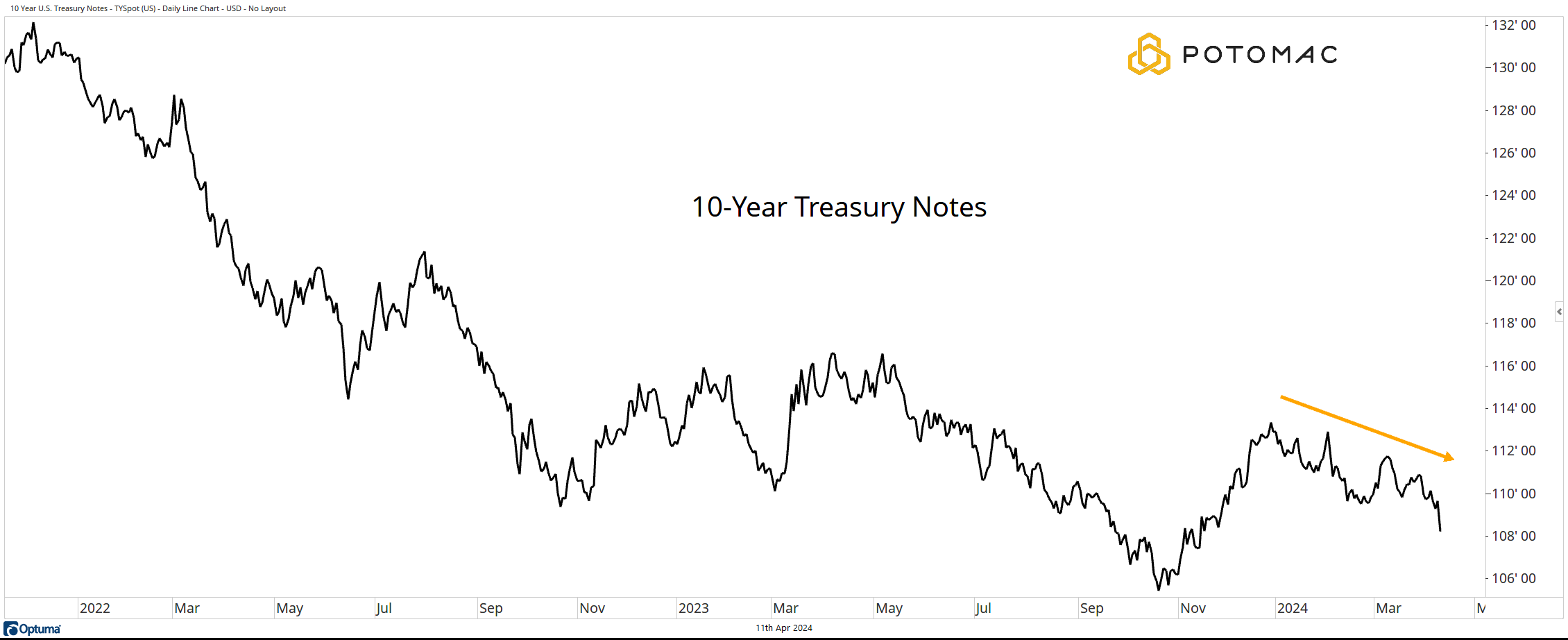
Perhaps the 10-Year Note is not the best proxy here.
To get a better sense of what the market thinks about the likely actions of the Federal Reserve we may be better served looking at the Two-Year Note. The Two-Year rallied through the fourth quarter of 2023 as investors began to expect cuts in 2024.
However, it has been moving lower in 2024. Why?
Because bond market traders and investors give lower odds to the narrative of three cuts in 2024. Just last week Neal Kashkari, a non-voting member of the Federal Reserve Board hinted at the possibility of no cuts.
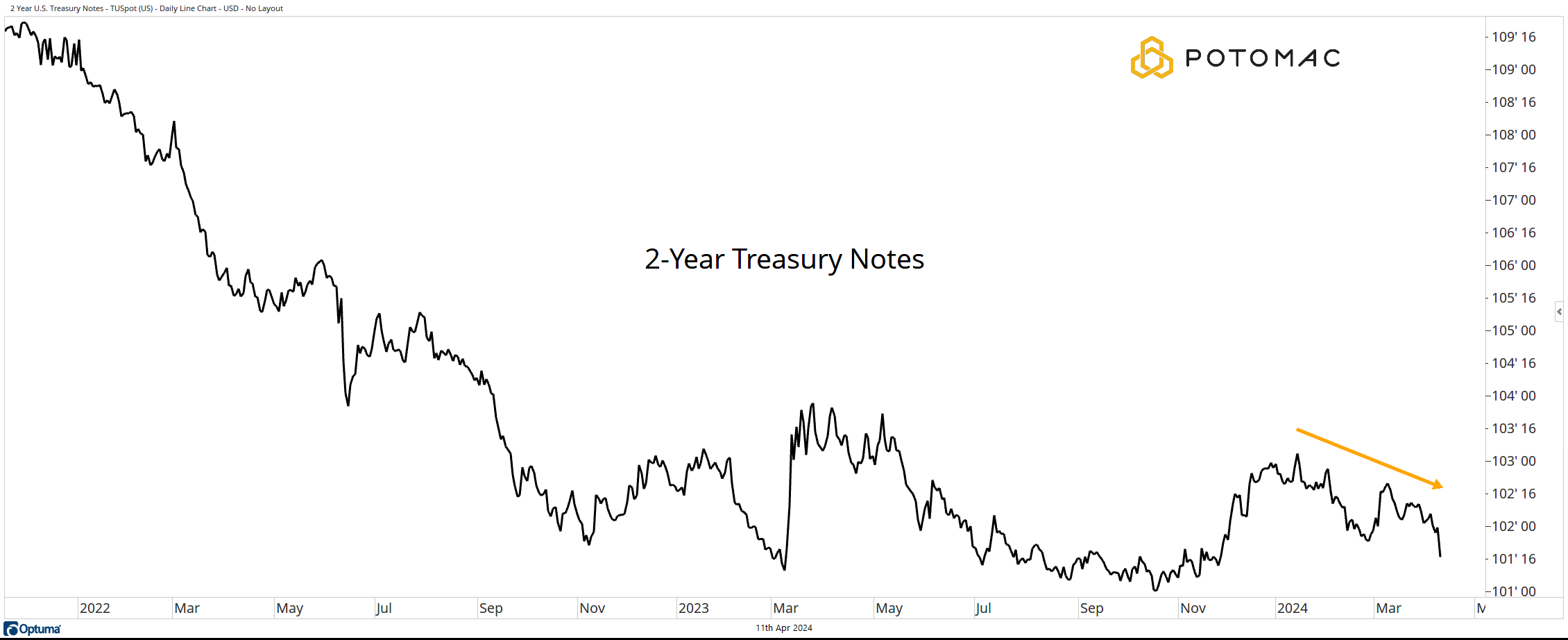
The same can be said for the commodity market where all four of the major subgroups have turned higher. Precious Metals are the standout on the back of a strong move in gold.
However, I am most interested in Agriculture. Aside from Oil in the Energy group, the Ags are where the average person “feels” inflation the most. This is the shopping cart. Agriculture is turning higher, and as I write on the morning of April 10th, the Consumer Price Index for March just printed higher than expected and higher than last month.
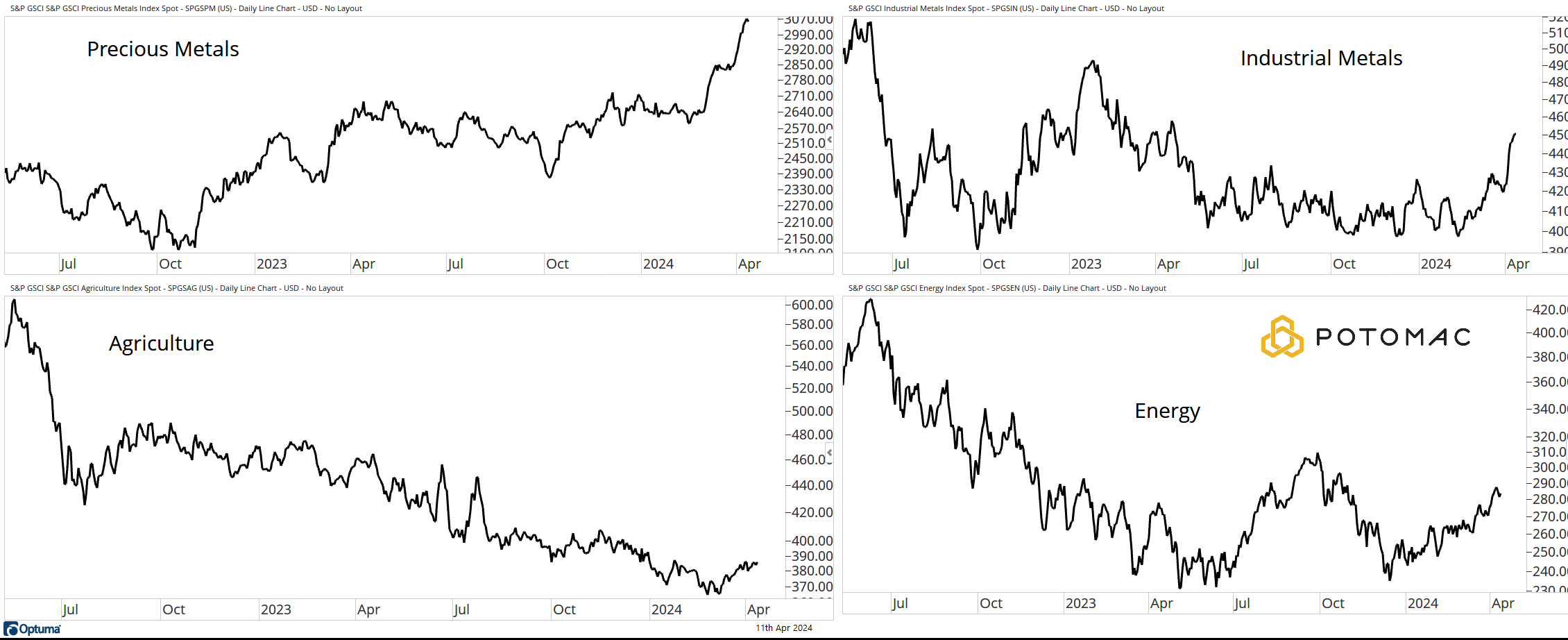
The investors who are buying commodities and selling treasuries are willingly choosing to be different. If they are right, they will be geniuses, but if they are wrong, they will have to answer some tough questions. For the record, I do not think that they are going to be wrong.
Also, for the record, I believe that most strategic portfolios have consensus positioning of little to no direct commodity exposure.
Over in the equity market, the consensus benchmark huggers continue to just keep buying equities. The S&P 500, NASDAQ 100, and the Dow Jones Industrial Average are all at/near all-time highs.
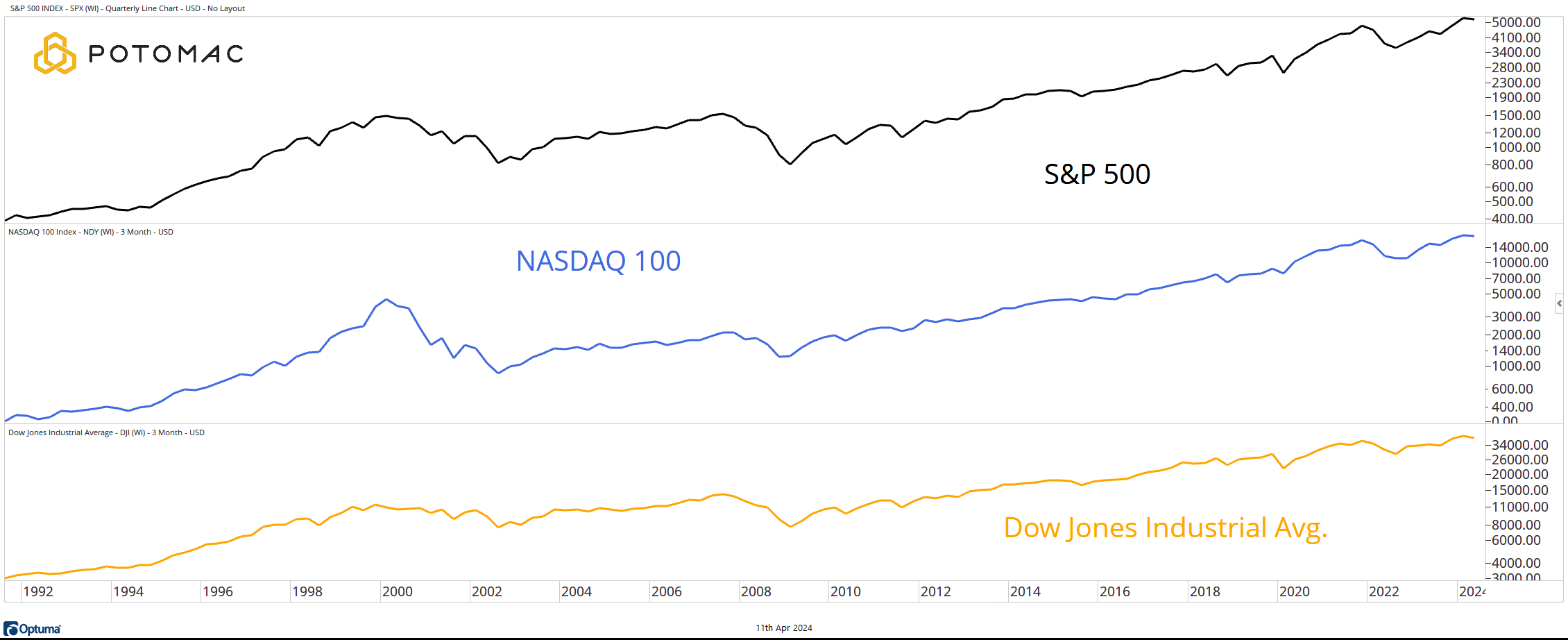
However, even in the equity market, there is a subtle shift playing that can be seen by those who are willing to look. During the first quarter, four of the top five performing sectors (Energy, Financials, Industrials, and Materials) look different from the Mag 7 leadership that lives in the Technology, Communication Services, and Consumer Discretionary sectors.
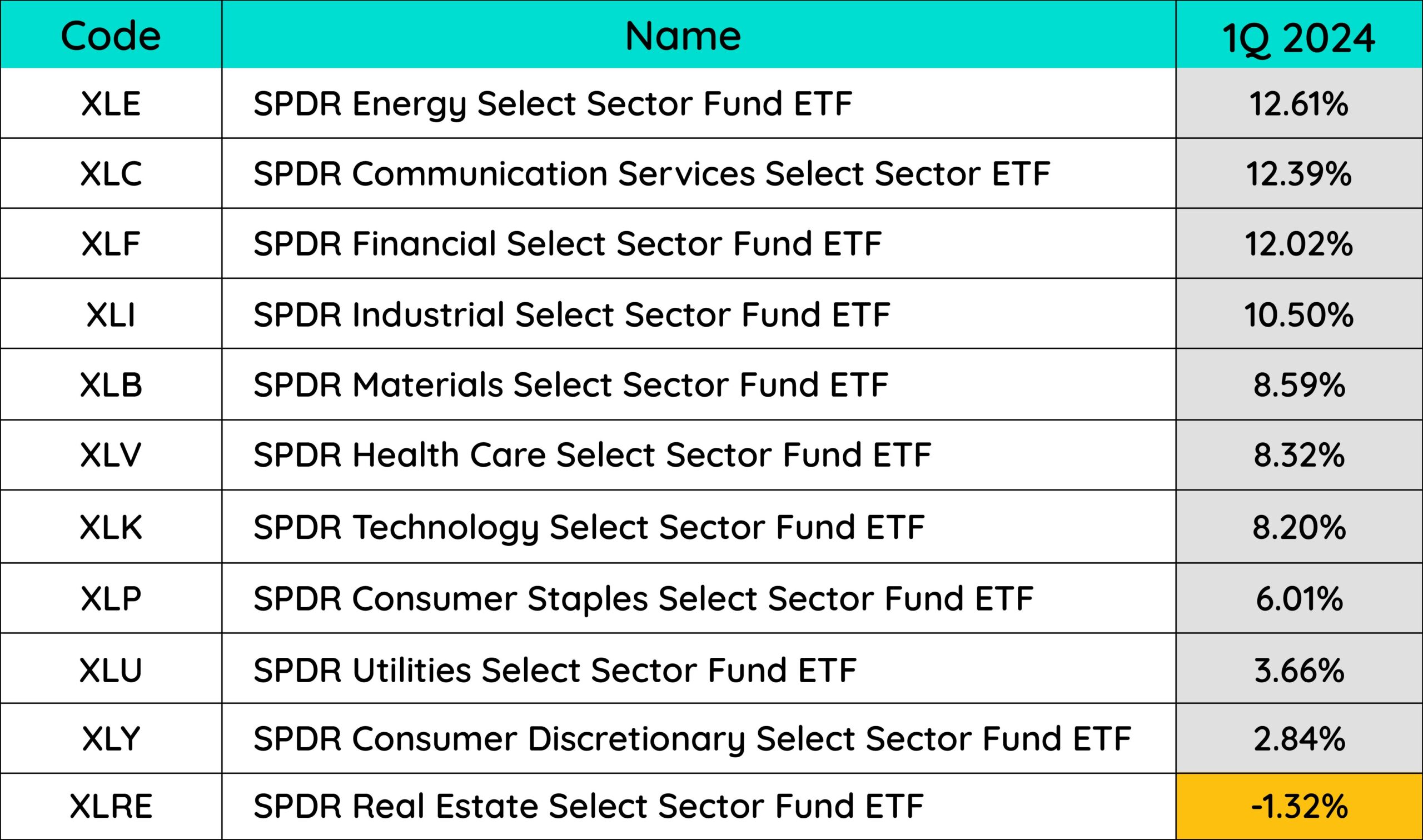
At Potomac, we choose to look different. In a world that has become bombarded with messages such as “just buy cheap passive funds” and “just keep buying,” we choose to be a tactical manager.
We willingly choose not to be benchmark huggers, largely because hugging the benchmark means that you experience the maximum drawdown of that benchmark. We do not think investors should have to take that ride.
We know that there are times when our approach will be questioned. However, we will continue to manage money according to our systematic process.
For the past year, hugging the equity benchmark has been the right call. The question is when the drawdown comes, are you comfortable taking that ride?
*All charts from Optuma as of the close of trading on April 10, 2024. Past performance does not guarantee future results.
Potomac Fund Management ("Company") is an SEC-registered investment adviser. SEC registration does not constitute an endorsement of the advisory firm by the SEC nor does it indicate that the advisory firm has attained a particular level of skill or ability. This information is prepared for general information only and should not be considered as individual investment advice nor as a solicitation to buy or offer to sell any securities. This material does not constitute any representation as to the suitability or appropriateness of any investment advisory program or security. Please visit our FULL DISCLOSURE page. The company does not make any representations or warranties as to the accuracy, timeliness, suitability, completeness, or relevance of any information prepared by any unaffiliated third party, whether linked to the Company website or incorporated herein, and takes no responsibility for any of this information. The views of the Company are subject to change and the Company is under no obligation to notify you of any changes. Different types of investments involve varying degrees of risk, and there can be no assurance that the future performance of any specific investment or investment strategy will be profitable or equal to any historical performance level.
PFM-318-20240412
